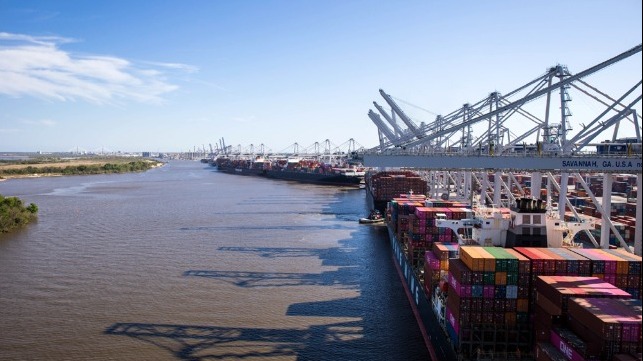Port of Savannah Reports Record Tonnage From Regional Growth

The Port of Savannah achieved a record in total tons and container tongs for its fiscal year 2020 that ended in June despite the disruptions resulting from COVID-19. The port’s role as the nation’s top exporter of containerized agricultural goods and expansion efforts continued to the positive results despite the overall downturn in the shipping industry.
Newly released figures show that the Port of Savannah had a slight increase of less than one percent in total tons to nearly 38 million tons while container tons grew two percent for the year. Container volume, homer, measured in TEUs was down less than one percent for the year.
“Cargo volume reductions related to COVID-19 were offset by the strength of our export markets and record volumes earlier in the year,” said Griff Lynch, GPA’s executive director. “This year’s better than expected performance is the result of excellent teamwork starting at the top with Governor Kemp and our board of directors who have been champions of our ports, to our GPA team members along with the International Longshoremen’s Association, the shipping lines, stevedores, trucking and rail.”
The port also pointed to its ongoing expansion projects, such as the harbor deepening and Mason Mega Rail, along with the overall growth in commercial infrastructure investment and industrial space as contributing to the results and outlook. For example, Port City Logistics recently announced an $80 million, 1.1 million square-foot development in the Savannah market as two major resin exporters were building out a total of 2 million square feet of new space.
In Northwest Georgia, the Appalachian Regional Port (ARP) handled more than three and a half times the cargo it did the year before, moving 27,132 containers, up 19,610 boxes. “As more customers learn the value the ARP brings to their operations, the facility continues to gain traction and build momentum,” Lynch said. “The inland port is a real success story for GPA, and we forecast business there to continue growing.”
Lynch also reported that the first nine of 18 Mason Mega Rail tracks are now moving cargo at the Port of Savannah, two new mobile harbor cranes have been added to Savannah’s Ocean Terminal and a new container yard will be completed at Ocean Terminal by year’s end. Twenty new rubber-tired gantry cranes are slated to arrive at Savannah terminals by December, three new rail-mounted gantry cranes are scheduled to go into service by the end of FY2021, and construction will start soon on the upcoming straightening of Berth 1 at Garden City Terminal to handle more 15,000-TEU vessels. GPA is also upgrading Berth 2 at Colonel’s Island in Brunswick for dedicated Roll-on/Roll-off service.
Lynch said adding new container yard space, doubling rail capacity to 2 million TEUs per year, and growing the fleet of yard and vessel cranes are all parts of GPA’s plan to increase annual capacity from 6 to 11 million TEUs. “We’re confident in the long-term strength of the U.S. economy and our ability to help port users reach their customers more effectively,” Lynch said.
Georgia’s deepwater ports and inland barge terminals support more than 439,000 jobs throughout the state annually and contribute $25 billion in income, $106 billion in revenue and $2.9 billion in state and local taxes to Georgia’s economy. The Port of Savannah handled 8.5 percent of U.S. containerized cargo volume and 10 percent of all U.S. containerized exports in FY2017.
